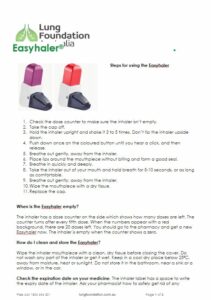The Easyhaler® is a dry powder inhaler commonly used for managing Chronic Obstructive Pulmonary Disease (COPD) in Australia. Unlike traditional inhalers, it does not require pressing a button while inhaling. Instead, the medication is released when the user takes a strong, deep breath. Correct inhaler technique is essential to ensure that the medication reaches the lungs effectively, helping to control symptoms and improve lung function. To support this, Lung Foundation Australia has created a fact sheet with clear, step-by-step instructions on how to use the Easyhaler® properly.
The fact sheet explains how to prepare the device for use. Users should first check the dose counter to ensure there are doses remaining. Next, the inhaler should be shaken three to five times to mix the medication. While keeping the inhaler upright, the coloured button must be pressed down once until a clicking sound is heard, indicating that the dose is ready.
To inhale the medication, users should exhale fully away from the inhaler before placing their lips around the mouthpiece, forming a firm seal without covering the air vents. A quick, deep breath in through the mouth will activate the medication release. After inhalation, the user should hold their breath for five to ten seconds before exhaling slowly. To ensure proper medication delivery, the mouthpiece should be wiped with a dry tissue before replacing the cap.
The fact sheet also highlights the importance of proper storage and monitoring. The dose counter decreases every fifth dose, and when numbers appear on a red background, there are 20 doses left, signalling the need for a replacement soon. Once the counter reaches zero, the inhaler is empty. The Easyhaler® should be stored in a cool, dry place below 25°C, away from heat, moisture, and direct sunlight. It should not be washed with water, as moisture can interfere with the medication.
Using the Easyhaler® correctly is a key part of managing COPD at home. Following the instructions in Lung Foundation Australia’s fact sheet ensures that medication is delivered effectively, improving lung function and symptom control. Regular check-ups with a healthcare professional can help confirm proper inhaler technique. For further support, people with COPD can access instructional videos and other COPD resources Australia-wide to help manage their condition with confidence.
Was this page helpful?
Good job! Please give your positive feedback
How could we improve this post? Please Help us.
